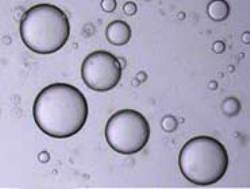May 10 2013
Researchers at the University of Bristol have led a new enquiry into how extremely small particles of silica (sand) can be used to design and construct artificial protocells in the laboratory. The work is described in an article published in Nature Chemistry.
 Image of an optical micrograph of silica nanoparticle-stabilized aqueous microcompartments
Image of an optical micrograph of silica nanoparticle-stabilized aqueous microcompartments
Cells are the basic unit of life and are separated from the outside world by a thin organic membrane. A major function of this membrane is to allow certain molecules to enter or leave the cell whilst other molecules are blocked from the cell interior. This allows metabolic processes to take place efficiently and selectively. Controlling membrane permeability is therefore a key challenge when building artificial cells in the form of enclosed chemical systems, particularly so when the membrane is constructed from simple inorganic components.
Professor Stephen Mann and Dr Mei Li in the School of Chemistry have now addressed this problem by attaching a thin polymer layer to the external surface of an artificial inorganic protocell built from silica nanoparticles.
When the polymer layer is absent, small molecules readily leach out of or permeate into the inorganic protocells, which render them ineffective for controlling chemical transformations in water. But when the polymer is attached to the silica nanoparticles, changes in pH can be used to regulate the charge on the membrane. As a consequence, small molecules with the same charge as the membrane are prevented from entering or leaving the protocell interior. In this way, the researchers show that an enzyme reaction inside the inorganic protocells can be switched on or off by controlling the membrane permeability.
Professor Stephen Mann said: "This work could open up new horizons in synthetic protocell research based on methods of non-biological self-organization. This approach could provide an important counterpart to more mainstream methods of synthetic biology. For example, compared with bioengineered cells, the artificial structures are extremely primitive and unable to evolve, but these attributes might make them particularly safe as materials for delivering drugs and genes, sequestering toxic agents, or sensing important metabolites."